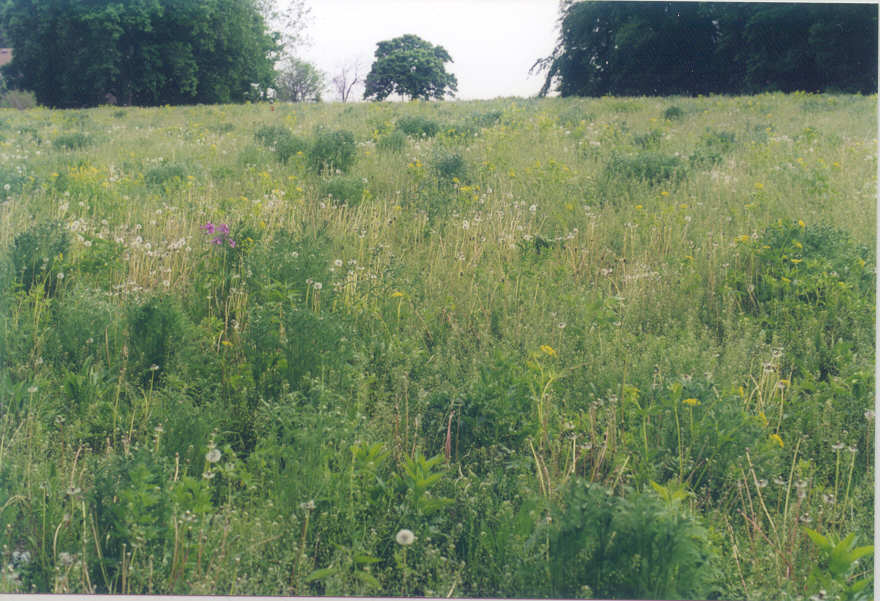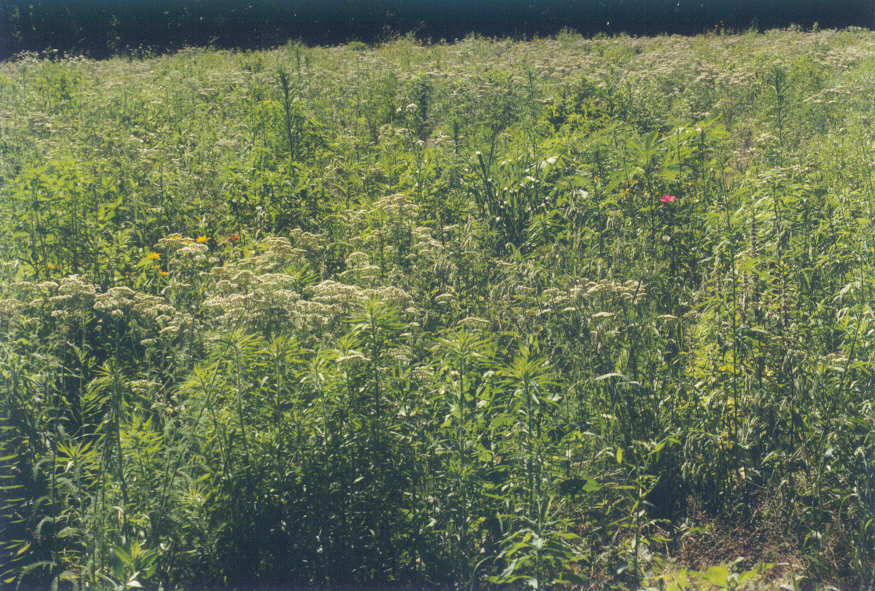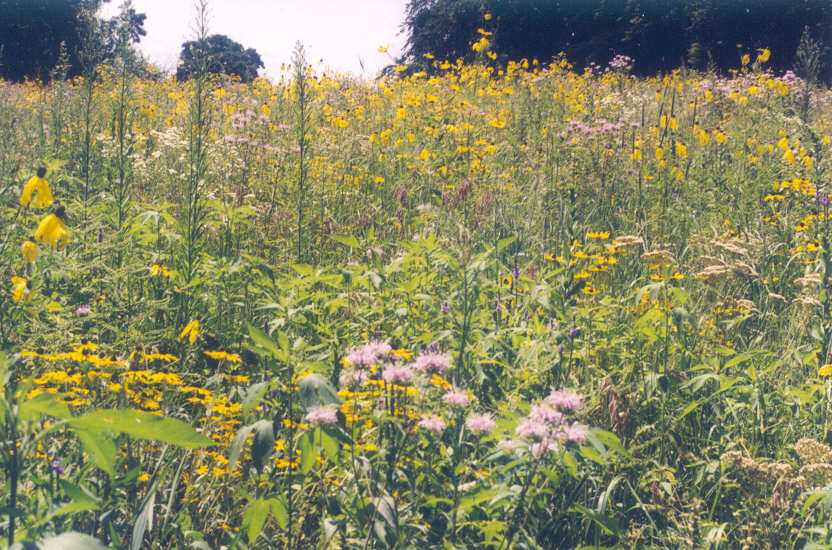
Our field was farmland for many years. Despite this, several native forbs have persisted in the scrub woodlands and ravines adjoining it on 3 sides. Whether this is a prairie restoration or a prairie reconstruction, who knows!
October, 2001
A large area (2 acres of a 2.7 acre field) adjacent to the 400 square foot test plot has been put into CRP program. Corn harvested from this field in 3rd week of October. Stocks were chopped and field was disked twice. DNR Forester reports soil condition excellent for seeding. The entire 2.7 acres will be seeded with prairie species. Seed list follows:
"Bison" Big Bluestem--6.5 lbs.
"Tomahawk" Indian Grass--6.5 lbs.
"Dakota" Switchgrass--4.0 lbs.
"Badlands" Little Bluestem--4.5 lbs.
Prairie Forbs Mixture--2 lbs.
Randy Schindle, the DNR Forester is supplying the forbs mixture. Grasses are from Albert Lea Seed House. Seeding will be done this week if weather conditions permit. Soil condition is dry, fairly fine consistency with quite a bit of cornstalk debris in some areas.
5 November 5, 2001
Randy Schindle dragged the 2.7 acre field and planted it. Soil condition is dry; pretty good consistency except for back area which still has some larger clods. At the very beginning of the field (south entrance) we hand seeded a large amount of the mixed prairie flowers and the little bluestem and sideoats grama from Dan Williams. A stiff wind from the south aided the distribution! The hand-seeded area is, perhaps, 800 square feet. The little bluestem in this area is from seed grown in Fertile, MN by Kaste Inc. through Albert Lea Seed House for 1998 season. Sideoats grama is Butte Side Oats Grama, origin is MN, and also is from ALSH.
The seeder was set to seed light since some of the grass seed had been de-bearded. Dispersion should be great, since Randy seeded entire area first north to south, then east to west and then overseeded at random to use up remaining seed.
Prairie Flower List for 2.7 acre field
(Achillea millifolium) Yarrow-1 ounce
(Allium canadense) Wild Garlic-2 ounces
(Allium stellatum) Prairie Onion-1/4 ounce
(Asclepias tuberosa) Butterfly Weed-1/2 ounce
(Coreopsis palmata) Stiff tickseed-1/4 ounce
(Dalea candida) White Prairie Clover-1/2 ounce
(Dalea purpurea) Purple Prairie Clover-2 ounces
(Desmodium canadense) Prairie Larkspur-1 gram
(Echinacea pallida) Pale Purple Coneflower-1/4 ounce
(Eryngium yuccifolium) Rattlesnake Master-4 ounces
(Heliopsis helianthoides)* Common Oxeye-1/2 ounce
(Heuchera richardsonii)* Alum root-1 gram
(Lespedeza capitata) Prairie Bush Clover-1/2 ounce
(Liatris ligulistylis) Meadow Blazing Star-3 ounces
(Liatris punctata) Dotted Blazing Star-1/4 ounce
(Liatris pycnostachya) Prairie Blazing Star-4 ounces
(Lupinus perrenis)* Wild Lupine-1/2 ounce
(Monarda fistulosa) Wild Bergamot*--1/2 ounce
(Penstemon grandiflorus)* Showy Penstemon-1 ounce
(Phlox pilosa) Prairie phlox-1/4 ounce
(Potentilla arguta)* Prairie Cinquefoil-1 ounce
(Ratibida columnifera) Long Headed Coneflower-1/2 ounce
(Ratibida pinnata)* Yellow Coneflower-4 ounces
(Rudbeckia hirta)* Black-eyed Susan-1/2 ounce
(Silphium perfoliatum)* Compass Plant-1 ounce
(Soligado rigida) Stiff Goldenrod-2 ounces
(Solidago speciosa)* Showy Goldenrod-2 ounces
(Verbena hastata)* Hoary Vervain* --3 ounces
(Zizea aptera)* Heart-leaf Golden Alexanders--1.5 ounces
(Zizea aurea) Golden Alexanders--1.5 ounces
In addition, we added � to � ounce of Butterfly Weed seed that Jo-Ann and I collected off our plant in the garden.
March 30, 2002
Hand-seeded additional 3 lb. PLS (4.5 lb. bulk) grasses seed on 2.7 acre plot. Deluxe prairie grass mixture from Feder's of Blue Earth, MN. Species list follows:
40% Little Bluestem 35% Side Oats Grama 10% Blue Grama 10% Prairie Brome 5% Rough Dropseed
I added this seed for diversity, adding a second strain of Little Bluestem as well as the others of which we had none except the small amount of Side Oats Grama from Dan Williams, our neighbor. The Prairie Brome is a cool-season grass, however, Randy Schindle says it will cause no problems in this situation. Feder's indicated it can function as a nurse species for the grasses. Seeded most heavily in the areas adjacent to our yard. The entire field was seeded north-south and east-west, with the trips being about 10 yards apart. Also added seed to problem areas on east and west edges, which are mostly ragweed with some cockleburs. Also seeded tallgrass area (Reed Canary) along lilac hedge near our neighbor's fence, and along N. edge of east lawn and suitable spots in pond area.
Soil condition is moist, except, very moist on areas of eastern and north borders. No snow cover. Winter very mild with occasional snowfalls and melting between snowfalls. The frost appears to be out.
June 17, 2002
Dave Pongratz mowed off the field with brush mower. Vegetation is sparse except for ragweed, which is very thick in some areas. Evidently the herbicide used on the corn the preceding year is inhibiting weeds to quite an extent.
July 14, 2002
Some coneflowers and black-eyed susans as well as several grasses appeared in large plot. Found one plant of Blue Grama with a seed head. Ragweed large again, foxtail and other weeds coming more vigorously. Asked Dave to mow again. Small plot has profusion of blooming coneflowers, black-eyed susan, wooly verbena, and others. Some grasses coming.
July 16, 2002
Examined field in more detail. I believe I have identified at least three native grasses as well as several types of flowers. Ragweed and Foxtail two feet high in places.
July 18, 2002
Second mowing. Jo-Ann and I removed some of the heaviest plant debris so plants wouldn't smother. Spotted a blue grama or two and other plants I hope and suspect are native grasses. Also scattered Black-eyed Susans.
August 13, 2002
Third mowing. The annual weeds were not as thick this time, so no debris needed to be removed. Several forbs are prevalent, including Black-eyed Susans and (in the area near the driveway) large-flowered penstemon. Positive identification of side oats grama, blue grama, big bluestem and switchgrass. Pretty sure of little bluestem, but no positive id. Indian grass--I hope! I have spotted a grass that is not giant foxtail but having very large leaves and a head not unlike the pictures I have seen (This turned out to not be a native grass.). Most areas seem to have a good mix of grasses. The grasses seem to be heaviest where annuals were kept down by last year's herbicide! The annuals on perimeter (mostly foxtail) are heavy although not too tall, and it is hard to spot native grasses in those areas. The grasses are robust in most areas (considering this is the first year!). I went out to inspect one evening, a few days after a 1.5 inch rainfall (had been very dry the preceding 6 weeks), and went, "WOW!" Everything native had taken a giant jump. Numerous blue grama plants with the distinctive seed heads. Randy Schindle inspected the stand a couple weeks ago and said it looked really good. The small plot has tons of flowers and has bloomed continuously all summer. A little Canadian Rye and a couple Big Bluestem plants are flowering. I hope there are other grasses under all those tall flowers. We have now gotten another .45" of rain since the 1.5". I went out and dabbed Canada Thistles and Dandelion plants with Roundup about a week ago, a fairly strong mix. Used a small throwaway painting sponge on a stick; it worked very well.
September 8, 2002
The third mowing was a bit shorter than most sources recommend--about 4 inches. There was a substantial rain (over 1/2") just prior to the mowing. The grasses look to be in good shape. There are scattered blooms of Switchgrass, Big Bluestem, Side Oats Grama, Blue Grama and Indian Grass. The forbs also look healthy. I am continuing to spot treat thistles, dandelion and burdock plants with Roundup. Mature burdock plants adjacent to the field have been cut down and removed. I've also weed-whacked quite a lot of the remaining ragweed on the perimeter. There are several areas with less vegetation than the rest of the field. We plan to overseed in November.
November 9, 2002
The field looks to be in very good shape. Many of the grasses sent up seed heads even after the 3rd mowing. The height of the grasses varied from several inches (Blue Grama) up to a few individuals at 4 feet (Big Bluestem). This was considerably more impressive than what I was led to expect from various restoration books I studied. Several species of forbs are in great evidence, most notably, Yarrow, Hoary Vervain and Black-eyed Susan. There is still plenty of open space with bare dirt between plants, so we are opting to overseed. We don't yet know how much the forb diversity may have been affected by seeding a field that had raised corn (been sprayed with Atrazine) the year before. My battle with the Ragweed was 99% successful. I also cut down and physically removed all the Burdock I could find on the field perimeter. Despite that, I have seen 2 or 3 plants I missed. A lot of stunted Foxtail jumped up at the last moment, but there wasn't much to be done unless we mowed the field off again very short. I decided against this because the prairie plants appeared healthy and determined to grow. I couldn't bear to cut them off a 4th time! 2.7 acre field was overseeded today with a wide variety of forbs from various sources which I will detail here as soon as I have the time. We also added some grasses, especially to areas that appeared deficient.
April 22, 2003
I mowed a 40-50 foot perimeter around the field, as this was the area with the most early weeds greening up. I also worked over the winter at removing brush, fallen branches and burdock plants and seeds from the borders.
April 27, 2003
A number of forbs are growing. The Yarrow seems most energetic right now. The native grasses are just beginning to send up green shoots. You have to pull aside the dead vegetation to find signs of life.
June 6, 2003
The grasses and forbs are growing robustly under conditions of normal moisture. So are two varieties of thistle! I've been out battling the more prolific of the two every day. Click on the link on my prairie home page to view the thistles. Below is a photo of the planting in late May, 2003. Besides the dandelions, many Golden Alexander plants are in bloom, and some prairie phlox. Large green Yarrow plants are also notable.

Below is a shot from the same general area taken in late June. Many tall weeds are visible in the foreground. In the prairie, Yarrow plants are displaying their white blooms as the first poppy mallow and Black-eyed Susan blossoms appear!

Below is the same area near the end of July. Coneflowers, Black-eyed Susan and Wild Bergamot (violet colored flowers) are visible.

May 29, 2004
During the winter I worked on the borders of this field, cutting back the wild raspberry brambles and brush on the east and west sides. There are a few pioneer prairie plants in these areas, but also lots of Nettles, Reed Canary Grass, Burdock and others. I scattered some Cup Plant and Wild Rye seed along the western area, and a little Big Bluestem along the east.
The field was burned on April 12th and things began to turn green within three days!
The grasses are doing very well in the field. Even the thistles may have a hard time competing in another month. The Rattlesnake Master seems to really like this area. All of its numerous specimen are robust. There is less Yarrow than last year, but still a good amount. The Golden Alexanders are currently blooming, as well as a few Wild Lupines. The Large-Flowered Penstemons are on the verge of blooming.
The Canadian Thistle problem is far less severe in the southwest (shorter prairie) corner than it was last year. There are a few small ones to be found, but it is looking like this area may actually be thistle-free some day!
May 7, 2008
To reduce redundancy, news of this, our "main prairie" area is now being posted on our Prairielog: What's New? page.
Click Here To Return To Our Prairie Home Page